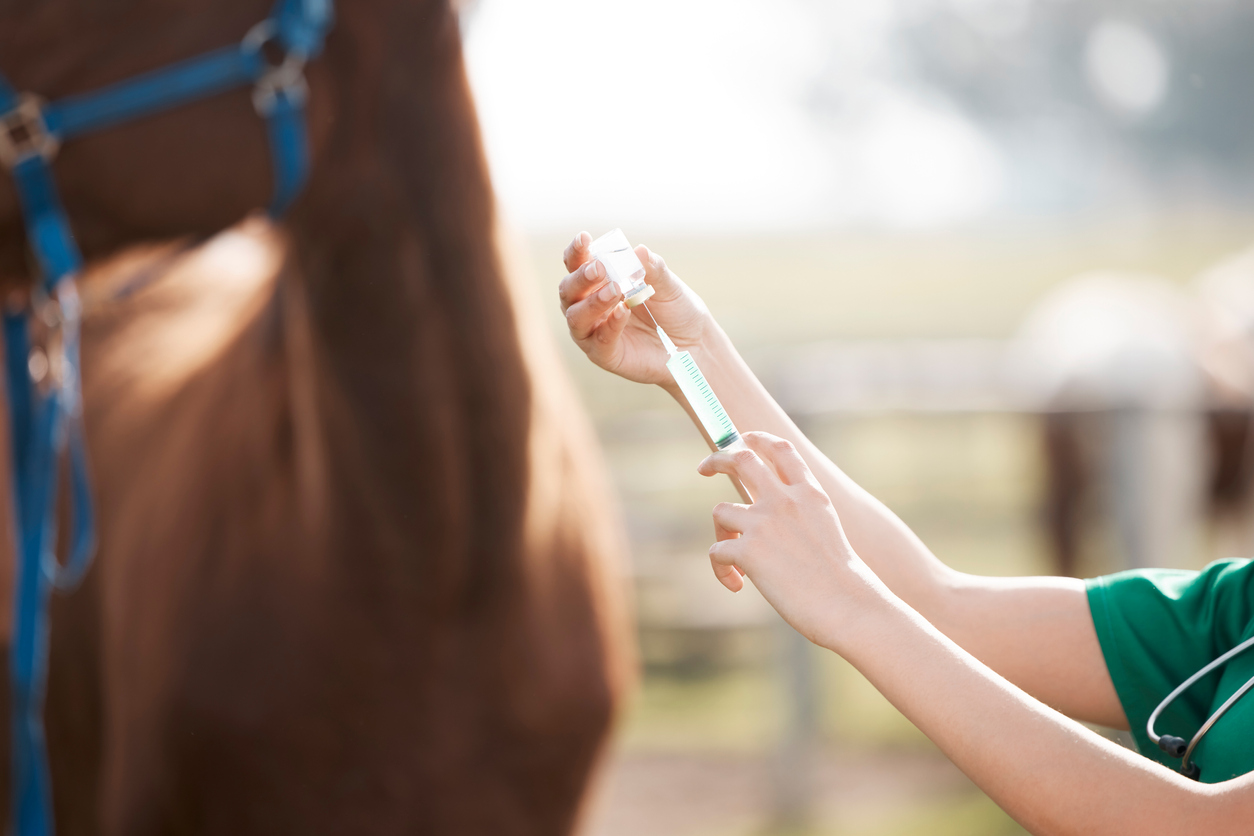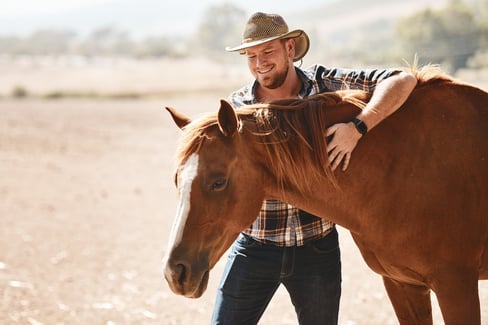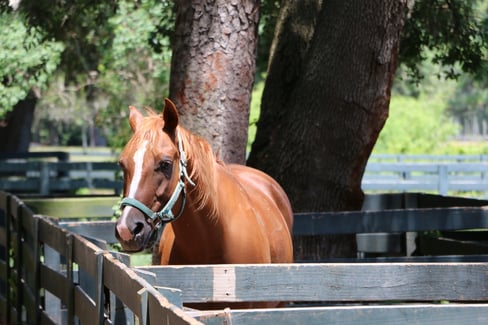Table of Contents
When your horse's joints are sore and stiff, it can be difficult to get them back in shape. Luckily, there are a variety of joint injection options available for horses that can help ease their pain and stiffness.
Joint injections for horses can be a helpful treatment option for the management of joint problems from simple aches and pains to advanced osteoarthritis. However, there are many factors to consider before deciding whether or not you would like to try this treatment.
In this guide, we'll explore the pros, cons, possible side effects and cost of joint injections for horses as well as potential alternative treatment options. That way, you can make an informed decision about whether or not they're right for your animal!
Are you ready to learn more? Let's get started!
What are Horse Joint Injections?
Now that we've covered the basics, let's get into the nitty-gritty.
What are horse joint injections, exactly? And an injection is an injection, right? Not exactly.
Horse joint injections are different from traditional shots in a few ways. Their purpose and ingredients differ based on what they're treating, so it's critical to know what type you're looking at before making a purchase decision. In this article, we'll cover everything from the common types of horse joint injections to potential side effects and cost considerations.
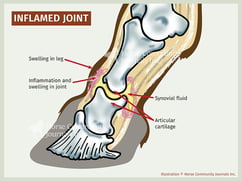
Joint injections, also known as intra-articular (IA) injections, are a form of treatment that uses a needle to inject a substance into an animal's joint, delivering medication right to the source to heal inflamed joints, such as in the diagram below. This substance is usually a supplement or medication that is used to treat pain or inflammation in an injured area of your horse's body.
Injections can be given by a veterinarian or other trained professional at any time during rehabilitation from surgery, after injury, or part of a performance upkeep program.
The veterinarian or other trained professional inserts a needle into the joint and injects the medication directly into the joint, where it begins to work on the injured or inflamed area. Injections can be given in one area of the body, such as a single joint, or throughout several areas at once.
Horse joint injections are often used as part of a rehabilitation plan after surgery to treat:
- Osteoarthritis
- Ligament or tendon injuries
- Stress and repetitive strain aches and pains
Horse joint injections can also be given in the early stages of an injury to relieve pain and inflammation and help horses get back on their feet sooner.
Horse Joint Injections Areas
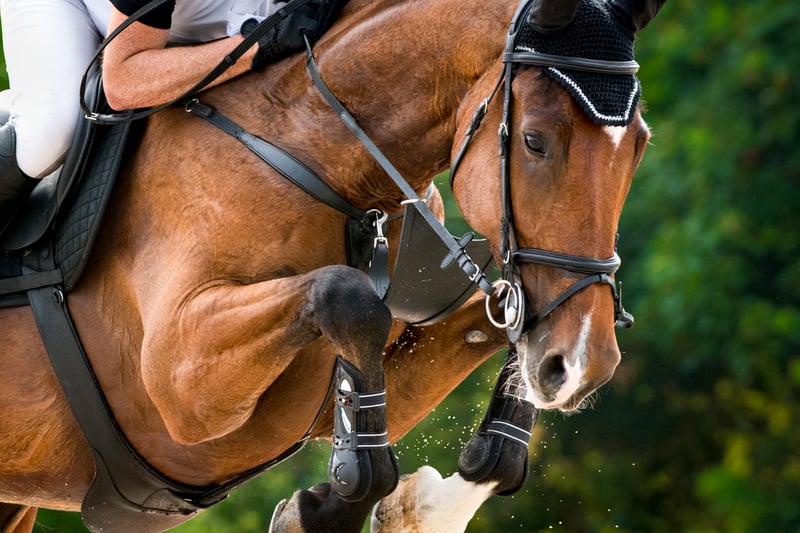
There are several areas where joint injections can be used to treat a horse.
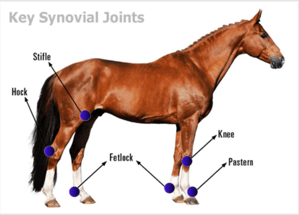
A few of the most common horse joint injection areas are:
- Lumbar
- Stifle
- SI joint
- Hock
- Joints of foot
- Joints of the leg and hip
Your horse may receive injections in one or more of these areas to relieve pain and discomfort. Your veterinarian will be able to choose the best ways to target pain in your horse's body and which joints need the most attention. The site of the injection will vary, depending on what is being treated.
The table below outlines common areas where joints are treated by injection and what they can help with.
|
Horse Joint Injection Area |
Description |
|
Stifle Joint Injection Horse |
|
|
Horse Coffin Joint Injections |
|
|
Horse SI Joint Injections |
|
When in doubt about which horse joint injections areas should be addressed first, ask your vet. They will be able to run diagnostic tests, examine your horse for signs of trouble throughout its body, and ensure you are treating the problem right at the source.
Types of Horse Joint Injections
Horse joint injections are a common treatment method for managing arthritis in horses.
There are several types of treatments that can be used to relieve pain and discomfort, but many veterinarians will recommend the following, as outlined in the table below.
|
Type of Injection |
Description |
|
Hyaluronic acid horse joint injection |
This type of injection is often recommended when you're trying to manage chronic arthritis. It works by injecting hyaluronic acid into your horse's joints, which helps them stay lubricated and healthy as they age. However, this approach isn't ideal for acute cases of inflammation since it takes weeks for these effects to take place once administered. |
|
Glucosamine injections for horses |
Glucosamine is another popular treatment for arthritis in horses. It works by providing your horse with the building blocks needed to repair cartilage, which can help reduce inflammation and pain. |
|
Corticosteroid injections |
Usually recommended for acute cases where there's definite swelling around a joint site but no pain or lameness yet present. Corticosteroid injections provide immediate relief from inflammation by reducing swelling so that your horse can move more easily without experiencing any pain whatsoever during movement (though it won't actually cure their condition). Some experts warn against using corticosteroids too frequently because repeated use could damage your horse's joints even further over time. |
|
Polysulfated glycosaminoglycans (PSGAGs) |
This is a type of medication that's been found to reduce pain and swelling in joints, as well as increase mobility in horses with osteoarthritis. It's typically administered via intramuscular injection once every four days for the first two weeks and then once every five to seven days after that. |
Your vet will be able to recommend the best course of horse joint injections for your equine's unique needs, age, and workload. In other words, don’t reach for the first thing you see off the shelf. Your horse needs to be assessed by your vet prior to getting started with joint injections in order to avoid negative outcomes, like a bad reaction or exacerbating the underlying issue.
Benefits of Horse Joint Injections
Benefits of Hyaluronic Acid Horse Joint Injection
Hyaluronic acid injections are a non-surgical treatment option for horses with joint pain and inflammation. The injections are made from hyaluronic acid, a naturally occurring substance in the body that helps lubricate joints. The injection may be administered into the horse's joint to help relieve pain, decrease inflammation and improve mobility.
The hyaluronic acid injection is typically given as an outpatient procedure under local anesthesia. Treatment generally takes only a few minutes and can be repeated as needed.
It is worth considering the overall benefits of hyaluronic acid – and not just applied locally to a stiff and sore horse joint. A supplement like TRI-ACTA H.A. for Equine is able to deliver an oral dose of this joint health boosting ingredient in a simple daily serving. That way, your horse can reap the benefits of hyaluronic acid in more ways than one.
TRI-ACTA H.A. for Equine
Our maximum strength formula is perfect for horses that are ageing, experiencing arthritis and stiffness, are in training and competition, or under a heavy workload.
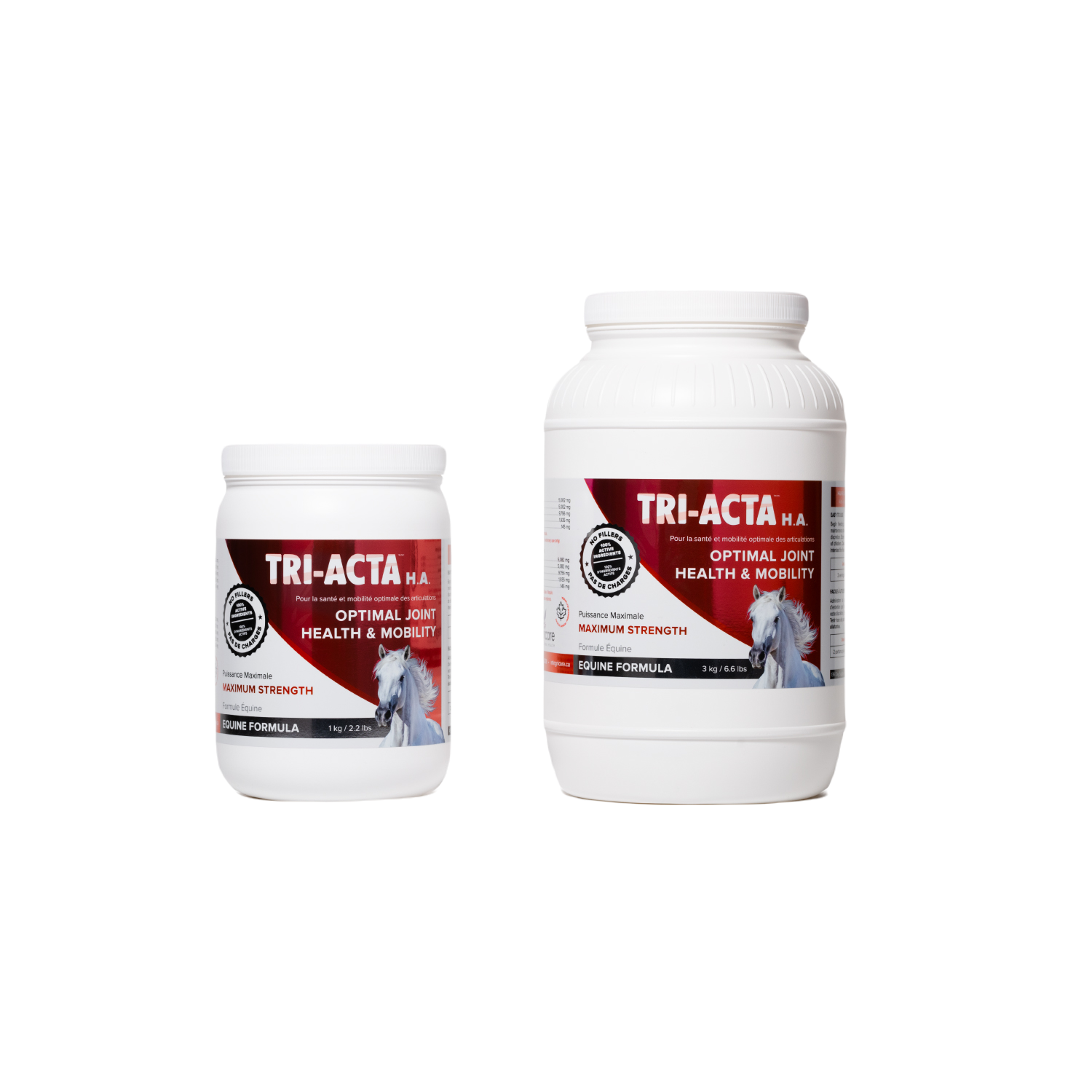
Benefits of Injectable Glucosamine for Horses
Glucosamine is a naturally occurring compound in the body. It is a building block for proteins, and it helps form cartilage, ligaments, and tendons. When glucosamine is given to horses, it helps repair damaged joints, ligaments, and tendons by stimulating the production of collagen.
Glucosamine can be given as an oral supplement or as an injectable drug. Injectable glucosamine is beneficial for horses’ joints and health because it works directly on their joints to help repair damage and reduce pain.
Injectable glucosamine for horses has been shown to have many benefits for horses with joint problems:
- It can help reduce inflammation caused by damaged joints, which will allow your horse to move more freely and without pain
- It may help stop further damage from occurring as well as providing pain relief from existing damage
- It can help protect against further injury during exercise or work activities.
Glucosamine and chondroitin sulphate are commonly combined and used as nutraceuticals to help maintain healthy joints in horses. They are often combined with hyaluronic acid (HA), which is a naturally occurring lubricant found in the synovial fluid of joints. HA also acts as a shock absorber for bones, joints, and other connective tissues.
If you’re looking for a non-invasive alternative and something you can easily administer yourself, you may want to consider TRI-ACTA H.A. for Equine. With all the benefits of glucosamine and chondroitin, this daily supplement comes in a 100% active powder format. It can be an alternative to or used in conjunction with injectable glucosamine for horses. When used together, it can help delay the intervals and frequency of invasive injections.
Benefits of Corticosteroid Injections
Corticosteroid injections are a standard treatment for horses with joint problems. But what exactly are they, and what do they do?
Corticosteroids are a class of drugs that reduce inflammation by slowing down or stopping the immune system's response to injury. Typically corticosteroids are prescribed and administered by a veterinarian, but that is not always the case.
Some common corticosteroid joint injection medications include:
- Triamcinolone acetonide (an intermediate-acting steroid)
- Methylprednisolone acetate (long-acting)
- Betamethasone sodium phosphate-betamethasone acetate (intermediate and long-acting steroid)
The corticosteroid injection is given directly into the inflamed area of the joint, which helps reduce swelling and pain in that area. Corticosteroids can also help reduce any swelling in other parts of your horse's body due to the inflammatory process in his joints.
A corticosteroid injection helps control pain caused by inflammation in your horse's joints. Still, it does not cure the problem itself — only relieves symptoms for a short time. It can also have uncomfortable side effects (more on that later).
Benefits of Polysulfated Glycosaminoglycans (PSGAGs)
Horse owners have long been aware of the benefits of PSGAGs injections for horses' joints, and while there is waning support for these products in research, they are often used to treat equine joint pain.
This injectable product is characterized as a disease-modifying osteoarthritis agent (DMOAs) that slows cartilage destruction and contributes to increased joint comfort. The exact mechanism of action of PSGAGs isn't entirely known, but research suggests that they work by reducing inflammation and improving joint lubrication. This allows for more movement at the joint, which helps keep it healthy and prevents additional damage to the joint capsule or surrounding tissues from occurring.
Side Effects of Horse Joint Injections
Like any good horse parent, you want to know if your equine pal is going to encounter any side effects or painful after-effects. Side effects are not common with horse joint injections, but it’s good to be aware of potential things to go wrong in any case.
That said, the most common side effects of horse joint injections include:
- Infection
- Localized pain and swelling
- No improvement in lameness despite receiving injections
Details about those side effects of horse joint injections are outlined in the table below.
|
Side Effects of Horse Joint Injections |
Description |
|
Pain, swelling and redness at the injection site |
This is usually mild and short-lived. If your horse experiences any pain after joint injection, it's best to contact your vet right away so they can give you advice on managing the discomfort. |
|
Infection |
Infection at the injection site is rare but possible if proper hygiene procedures aren't followed during or after treatment. |
|
No improvement in lameness despite receiving injections for several treatments |
This could indicate that there are other factors contributing to your lame horse besides joint disease. For example, some horses with arthritis may also have bone spurs or osteoarthritis of other joints like kneecaps. If this is the case for yours, then they likely need more than just joint injections to be comfortable again! |
In very rare cases, horses can experience corticosteroid reactions, with some even leading to Cushings disease in horses after receiving long-term injections with corticosteroids.
Corticosteroids are a class of drugs that act like the naturally occurring hormone cortisol. Over time, these drugs can cause side effects due to excess production of adrenal gland hormones in your horse.
Horses with Cushing's disease, also known as Pituitary Pars Intermedia Dysfunction, have hormonal imbalances. It's caused by an abnormal pituitary gland, a pecan-sized gland at the base of the skull. Thanks to these abnormalities, cortisol production goes into overdrive. When cortisol levels are too high, insulin cannot absorb glucose in tissues and blood sugar levels are regulated, and the immune system is suppressed. Consequently, horses with Cushing's disease are more likely to contract infections or other diseases than healthy horses.
This condition can be triggered by corticosteroid overuse because their bodies essentially “forget” how to regulate normal levels of cortisol production.
Frequently Asked Questions
Horse joint injections can be a confusing, science-y topic that can leave the best of us with questions. Before you proceed to your vet and ask a bunch of questions, let’s get to the bottom of some of the most common questions about horse joint injections here.
Ready? Let’s get into the questions.
How Much Do Horse Joint Injections Cost?
It largely depends on the brand and formulation you choose, and if your trainer or even you can administer the drug or if a vet needs to be involved. For example, Adequan costs around $40 USD per injection, while Legend, an injectable hyaluronic acid, costs about $78 USD per dose and does need a vet to inject the formulation. Both require a loading dose followed by a tapering off of doses.
Many folks prefer Adequan over Legend because it costs less and is easier to administer. Adequan is a polysulfated glycosaminoglycan (PSGAG), which is proven to have an anti-inflammatory effect in the body, though Legend is just as helpful for horses with joint troubles. It's truly the best choice to go with your vet's personalized recommendation.
Horse Still Lame After Coffin Joint Injections – Now What?
What is a horse owner to do when a horse is still lame after coffin joint injections? If the horse is still lame after the injections, it may be due to an underlying condition or injury. A vet will need to perform a physical exam, along with x-rays and possibly blood work, to determine the cause of lameness. Because of this, it's important not to panic if your horse isn't feeling better right away.
Additionally, if there is trauma to the joint, the injection may only temporarily help and can mask the injury leading to further damage. That's why it's important to support horse joint injections with the addition of glucosamine supplements for horses in the form of an oral supplement. Products like Integricare's TRI-ACTA for Equine help support healing from the inside and treat pain and inflammation, offering your horse the added benefit of an oral supplement.
How Long Do Joint Injections Last in Horses?
The length of time that you will see benefits from a joint injection depends on the type of medication that you use. Some medications can last longer than others.
Generally speaking, though, corticosteroids last about 3 to 6 months, while ongoing glucosamine or hyaluronic acid shots may offer more lasting effects and help solve underlying problems while offering pain relief. Using TRI-ACTA H.A. in conjunction with injections can help increase the time between injections.
In Summary

Now that you've learned more about horse joint injections, it's time to decide what's best for your horse. You can speak with a veterinarian who specializes in equine medicine or visit a local clinic that offers this service. Remember that these injections aren't right for every horse, so be sure to discuss any potential risks with your vet beforehand!
And whether your horse is receiving joint injections or not, you should offer them a horse joint supplement like TRI-ACTA for equine. Oral supplementation can allow your horse the power to heal from injuries while experiencing the pain relief of a horse joint injection, as well as improved inflammation reduction throughout the body.
TRI-ACTA H.A. for Equine
Our maximum strength formula is perfect for horses that are ageing, experiencing arthritis and stiffness, are in training and competition, or under a heavy workload.

Newsletter Signup
Subscribe to our newsletter to receive the latest news and exclusive offers.
.jpg?height=2000&name=Cliick_Integricare-DISPLAY-REVISEDV2%20(1).jpg)
Proactive & Therapeutic Joint Supplements
When given daily, Integricare joint supplements recover bone and joint injuries faster and help prevent mobility injuries from happening in the first place.

